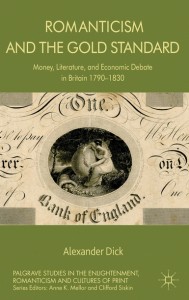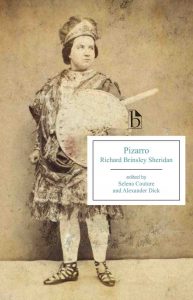 Romanticism and the Gold Standard: Money, Literature, and Economic Debate in Britain 1790-1830. Palgrave Studies in Enlightenment, Romanticism, and the Cultures of Print. Ed. Clifford Siskin and Anne Mellor. Houndsmills: Palgrave, 2013.
Romanticism and the Gold Standard: Money, Literature, and Economic Debate in Britain 1790-1830. Palgrave Studies in Enlightenment, Romanticism, and the Cultures of Print. Ed. Clifford Siskin and Anne Mellor. Houndsmills: Palgrave, 2013.
In 1816, the British government did something no one had ever done before: it introduced the first official gold standard in history. Through a close analysis of the pamphlets, reviews, lectures, journalism, editorials, poems, and novels surrounding the gold standard, this book examines its significance to the culture and literature of Romantic-era Britain. The gold standard was not a material object or universal concept, but a self-reflexive discourse that raised fundamental questions about knowledge, value, and social life. While politicians and financial experts believed that gold was the key to the nation’s economic confidence, writers such as Ricardo, Malthus, Coleridge, Shelley, Austen, and Scott transformed the debates on the standard into a new disposition reflecting the difficulties and ambivalence of modern commerce: embarrassment.
Nominated for the MLA First book award and for the British Association of Romantic Studies (BARS) First Book Award; reviews (to date) in Keats-Shelley Journal, Review of English Studies, Nineteenth-Century Literature, British Association of Romantic Studies Reviews, The British Society for Literature and Science, and The Year’s Work in Critical and Cultural Theory.
 Pizarro by Richard Brinsley Sheridan. Ed. Selena Couture and Alexander Dick. Broadview Press, 2017.
Pizarro by Richard Brinsley Sheridan. Ed. Selena Couture and Alexander Dick. Broadview Press, 2017.
Richard Brinsley Sheridan’s last play, an adaptation of August von Kotzebue’s Die Spanier in Peru first performed in 1799, was one of the most popular of the entire century. Set during the Spanish Conquest of Peru, Pizarro dramatizes English fears of invasion by Revolutionary France, but it is also surprisingly and critically engaged with Britain’s colonial exploits abroad. Pizarro is a play of firsts: the first use of music alongside action, the first collapsing set, the first production to inspire such celebratory ephemera as cartoons, portraits, postcards, even porcelain collector plates. Pizarro marks the end of eighteenth-century drama and the birth of a new theatrical culture.
This edition features a comprehensive introduction and extensive appendices documenting the play’s first successful performances and global influence. It will appeal to students and scholars of Romantic literature, theatre history, post-colonialism, and Indigenous studies.
“This exemplary edition of Sheridan’s spectacular melodrama demonstrates how the play made history in multiple ways—theatrically, technically, nationally, and imperially. The editors expertly bring together source materials and stage history to revivify the original context of the play, its production, and its reception.” —Joseph Roach, Sterling Professor of Theater, Yale University
Edited Collections
- Environmental Humanities and Sustainability Education: An Anthology. Co-edited with Derek Gladwin. Proposal in review with Routledge
- NASSR 2010: Romantic Mediations Special Conference Issue of European Romantic Review 22 (2011). 153 pages. Co-edited with Miranda Burgess and Michelle Levy.
- Spheres of Action: Speech and Performance in Romantic Culture. Toronto: University of Toronto Press, 2009. 353 pages. Co-edited with Angela Esterhammer. Reviewed in Notes and Queries, English Studies in Canada, and The Wordsworth Circle.
- Theory and Practice in the Eighteenth Century: Writing Between Philosophy and Literature. London: Pickering and Chatto, 2008. 313 pages. Co-edited with Christina Lupton. Reviewed in The University of Toronto Quarterly.
- Indigenes and Exoticism. Lumen: Proceedings of the Canadian Society for Eighteenth Century Studies 24 (2005). 174 pages.
Articles and Chapters
- “Blackwood’s Pastoralism and the Highland Clearances” in Using and Abusing Romantic Periodicals: Twelve Case Studies from Blackwood’s Edinburgh Magazine. Ed. Nicholas Mason and Tom Mole. Under contract with Edinburgh UP.
- “Objects Taken for Wonders in Equiano’s Interesting Narrative” in Romanticism and Speculative Realism. Ed. Anne McCarthy and Chris Washington, Bloosmbury Academic, 2019. 237-256.
- “Moderate Enlightenment and Religious Controversy in Eighteenth-Century Scotland.” The Eighteenth Century: Theory and Interpretation 58.4 (2017): 503-508.
- “‘A good deal of Trash’: Reading Societies, Religious Controversy, and Networks of Improvement in Eighteenth-Century Scotland.” Journal for Eighteenth-Century Studies 38 (2015): 585-598.
- “Frye, Derrida, and the University (to come)” in Educating the Imagination: Northrop Frye Past, Present, and Future Ed. Alan Bewell, Neil ten Kortenaar, and Germaine Warkentin (Montreal: McGill-Queen’s University Press, 2015), 114-131.
- “Justified or Just Making Excuses?” in Justified and Philosophy: Shoot First, Think Later. Ed. Rod Carveth and Robert Arp (Open Court), 2014. 121-130.
- “On Lecturing and Being Beautiful: Zadie Smith, Elaine Scarry, and the Liberal Aesthetic” (co-authored with Christina Lupton) English Studies in Canada 39 (2013): 115-137.
- “British Romanticism and Paper Money” Literature Compass 10 (2013): 696-704.
- “On the Financial Crash of 1825” BRANCH: Britain, Representation and Nineteenth-Century History. Ed. Dino Franco Felluga. Extension of Romanticism and Victorianism on the Net. 2012.
- “Scott and Political Economy” in The Edinburgh Companion to Walter Scott Ed. Fiona Robertson. Edinburgh UP, 2012. 118-129.
- “David Ricardo” in Burwick, Goslee, and Hoeveler, eds. Encyclopedia of Romantic Literature. Oxford: Wiley-Blackwell, 2012. 1120-25.
- “Walter Scott and the Financial Crash of 1825: Fiction, Speculation, and the Standard of Value” in Ian Haywood, ed. Romanticism, Forgery and the Credit Crunch. Romantic Circles Praxis Series, 2012.
- “William Wordsworth: Prose” in Burwick, Goslee, and Hoeveler, eds. Encyclopedia of Romantic Literature. Oxford: Wiley-Blackwell, 2012. 1529-36.
- “Austen, Sincerity, and the Standard” in Romanticism, Sincerity, and Authenticity. Ed. Tim Milnes and Kerry Sinanan. London: Palgrave, 2010. 221-237. Collection reviewed in Romanticism, Studies in the Novel, and 19th Century New Books Online.
- “New Work on Money in the Eighteenth Century” Eighteenth-Century Life 34 (2010): 105-13.
- “Wordsworth’s Lament” in Spheres of Action: Speech and Performance in Romantic Culture. Ed. Alexander Dick and Angela Esterhammer. Toronto: University of Toronto Press, 2009. 73-99.
- “Reid, Writing, and the Mechanics of Common Sense” in Theory and Practice in the Eighteenth Century: Writing Between Philosophy and Literature. Ed. Alexander Dick and Christina Lupton. London: Pickering and Chatto, 2008. 69-85.
- “Romanticism, Liberalism, Criticism.” European Romantic Review 19 (2008): 125-130.
- “The Ghost of Gold: Forgery Trials and the Standard of Value in Shelley’s Mask of Anarchy.” European Romantic Review 18 (2007): 381 – 400. This article won the ERR Outstanding Article Prize for 2007.
- “The Law of Contract and The Old Manor House” in Romantic Empiricism: Poetics and the Philosophy of Common Sense 1780-1830. Ed. Gavin Budge. Lewisberg: Bucknell UP, 2007. 112-140. Collection reviewed in Journal of Scottish Philosophy.
- “Romantic Drama and the Performative: A Reassessment” European Romantic Review 14 (2003): 97-115.
- “Charity, Poverty, Poetry: The Unproductive Labours of ‘The Old Cumberland Beggar.’” Studies in Romanticism 39 (2000): 365-96.
- “Citizen Khan.” Coleridge Bulletin 16 (2000): 31-39.
